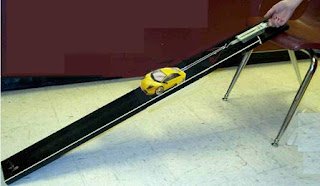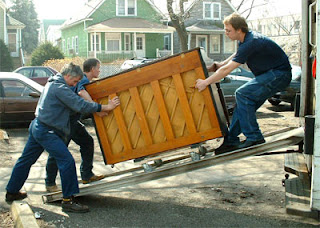Over the past few weeks, we've been learning about a couple very important physics topics. We've covered the relationships between mass, force, and acceleration; and we also went over Newton's 3 laws of motion.
Fan Cart Lab:
In this lab, we covered the relationships between force, mass, and acceleration by using a fan cart to measure accelerations. We began by finding the force of our fan cart set on high by placing a force probe on our track. (Shown below)
We found our force value to be -0.234 which we would later use to create our equation. We then proceded by measuring the acceleration of the cart with a variety of different weights placed on it. Using the logger pro application on the computers, we found the acceleration of the cart by looking at the slope of our graph. (Shown below)
(After collecting all of our data, we were able to organize everything into a data table as shown on our whiteboard.)
After completing our lab, we used our data values for force, mass, and acceleration to come up with the equation F = ma. (Force equals mass x acceleration) Our values for mass and acceleration didn't exactly match up with our force value when we plugged them into our equation, but after going back again to find a more exact force value, we found a better number that made more sense with our equation. We just didn't take our time when trying to find the force value the first time.
Newton's 3 Laws of Motion:
Aside from finding our F=ma equation, we also learned about Newton's 3 laws and how they applied to our everyday lives.
Hover Disk Lab:
In this lab, we spent most of the time sliding a hover disk across the floor and trying to figure out all the forces that were being felt by it. It was actually a tricky lab because we not only had to find the forces that applied to the disk, but also the forces that applied to the earth and each other.
For example, if I were to shove the disk over to my partner, there are lots of forces interacting that we usually don't think about. We were able to show these interactions with different diagrams.
(As we can see from the interaction diagram above, there are normal forces and gravitational forces acting between all four of the "objects" involved.)
We continued this lab with many more different scenarios involving the hover disk. Overall this lab just helped us to better understand the relationships going on between different things in our lives.
Newton's 1st Law:
Newton's 1st law states that any object at rest or constant speed will remain at rest or constant speed. This law applied to our hover disk lab, because we saw that if we left our disk alone and didn't push it, it would stay in the same spot. This law also applied when we pushed the disk across the floor and it continued moving at a constant speed because it was feeling no friction with the floor.
Newton's 2nd Law:
Newton's 2nd law states that acceleration is produced when a force acts on a mass. This law applied well to our fan cart lab where we found our own force values, and then used the acceleration from the fan cart, to arrive at the equation, F = ma.
Newton's 3rd Law:
Newton's 3rd law states that for every action, there is an equal and opposite reaction. Now we didn't have any labs that specifically applied to this law, but we talked about it a lot during class. For example, if someones hand were to press down on a table, that same force being applied to the table is also being equally applied to that hand.
Real World Application:
There are actually a lot of real world applications that we could take from these past few weeks. However, I think that Newton's 3rd law is the most common law that all of us have experienced without realizing it.
One of the best examples I can think of comes when watching baseball games. We don't think about it, but when the player's bat collides with the baseball, that is an example of equal and opposite reactions. Or when a football player kicks a field goal, there are equal and opposite reactions between his foot and the ball. But above all, the best visual example of Newton's 3rd law comes from the Newtons Cradle.



























